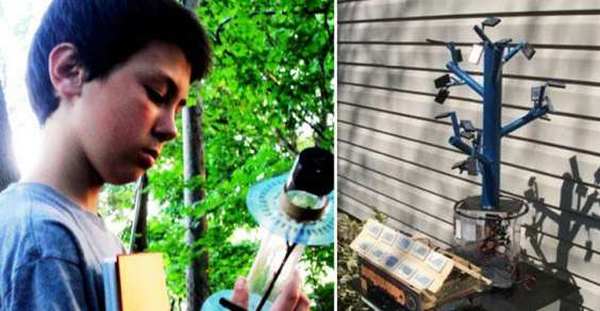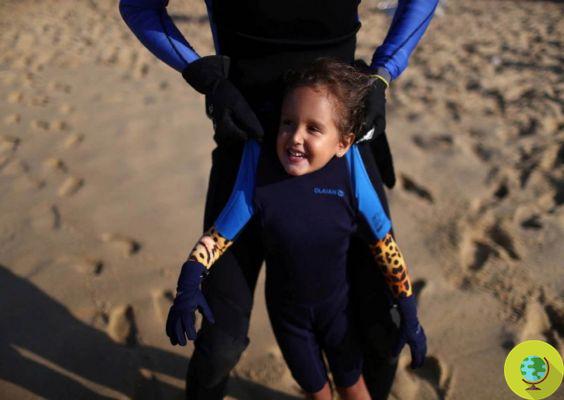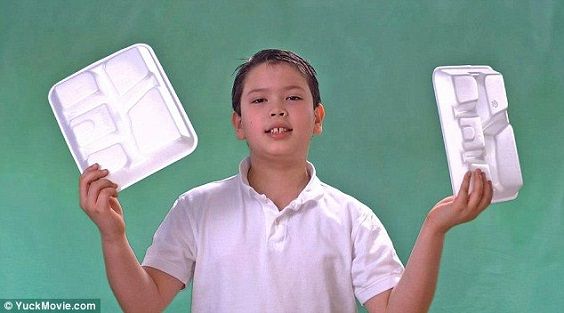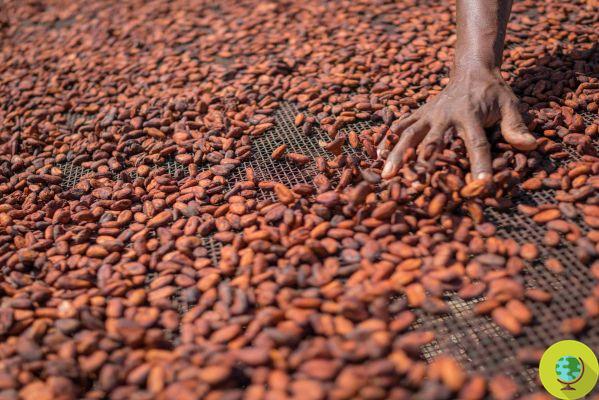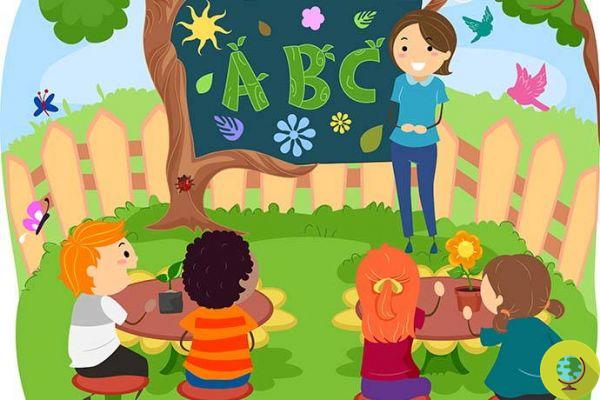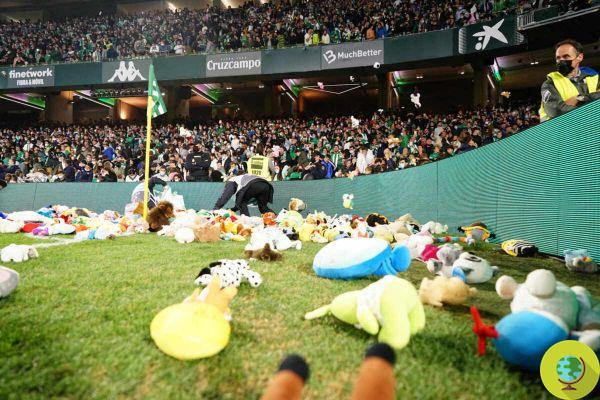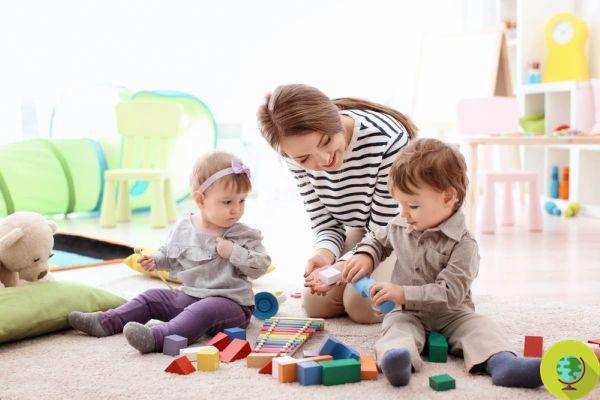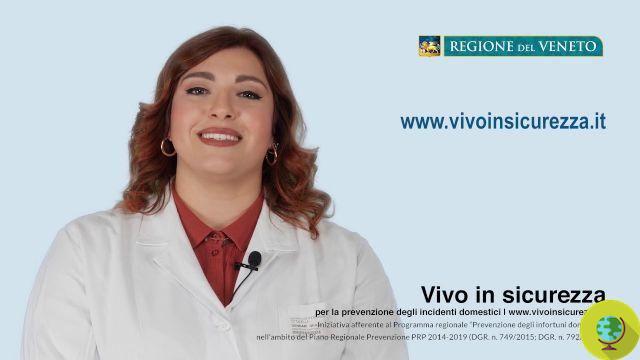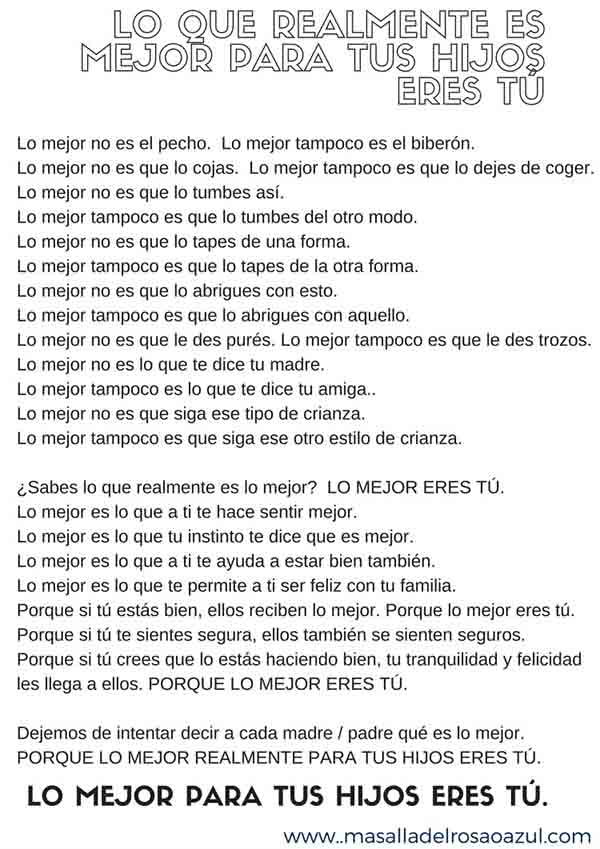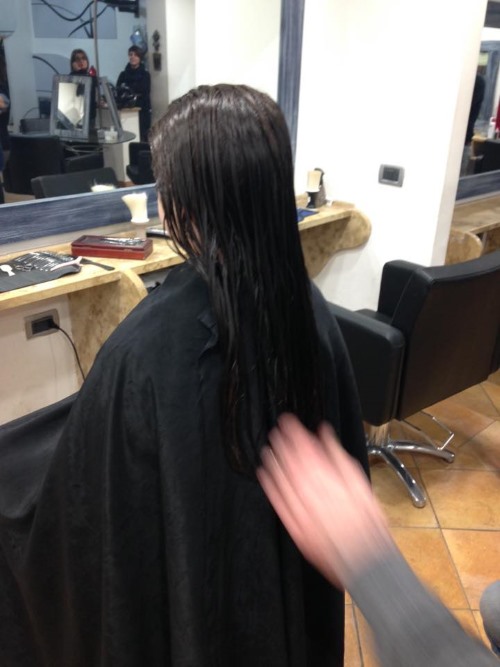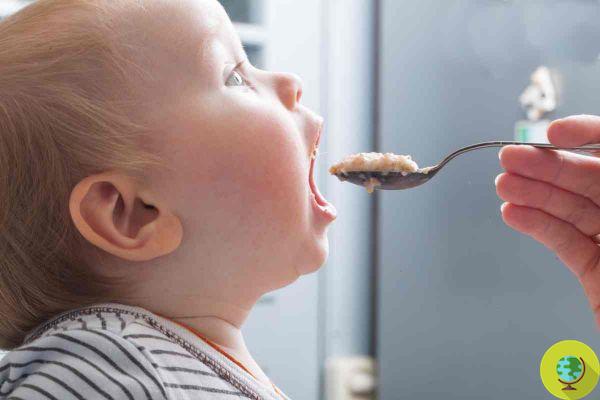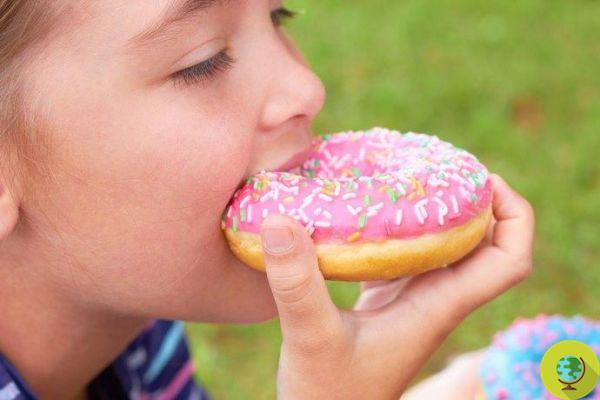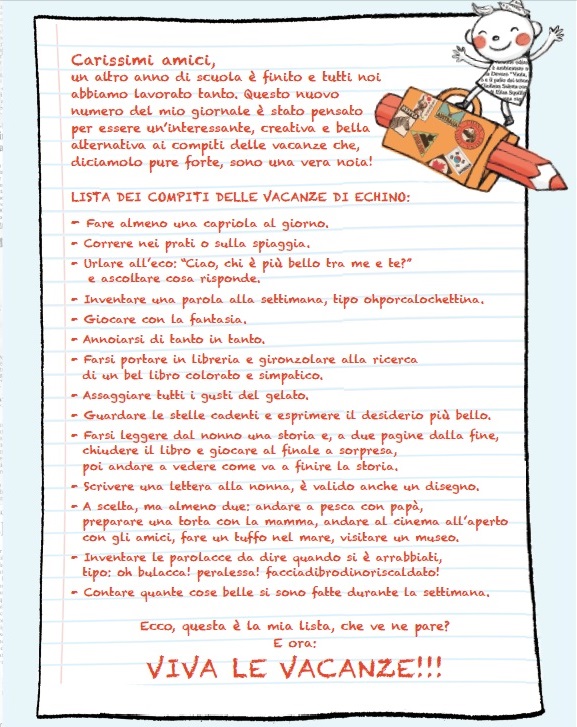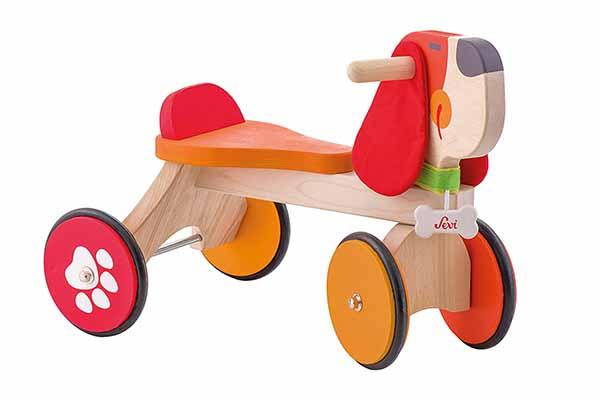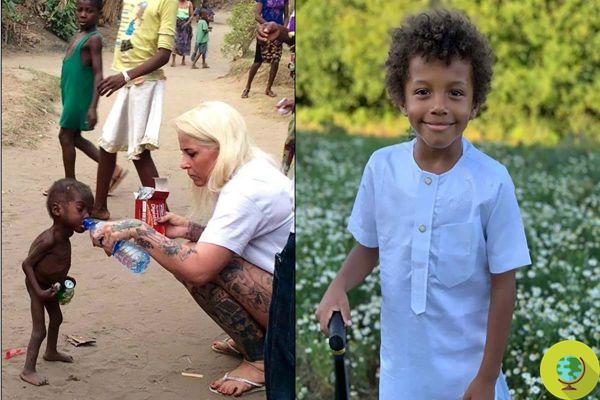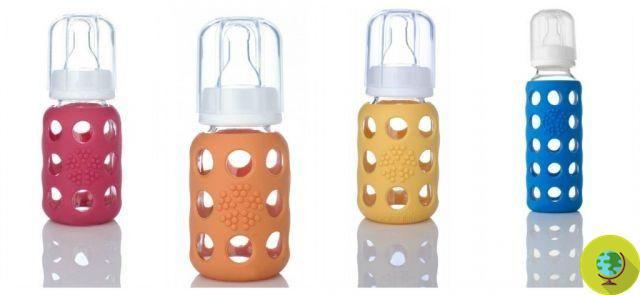When do babies first teeth appear? What are the remedies for pain relief? When to start brushing your teeth?
Don't store avocado like this: it's dangerousOne of the most important steps in a baby's development is the appearance of milk teeth (or deciduous teeth). A moment that can also be long and painful, especially when very large or pointed teeth such as molars and canines have to come out. Let's find out then when the first teeth appear and remedies to relieve pain.
Let's start by pointing out that each child is unique and therefore also his experience with the teeth could be very different from that of others (including any brothers or sisters). Not all children see their teeth appear according to the "calendar" of teething known by pediatricians as well as not all suffer particularly every time a new tooth emerges from the gums.
However, there are some general indications on the appearance of the so-called milk teeth compared to the months and years of the child's life. So let's see when deciduous teeth generally appear.
Index
WHEN DAIRY TEETH SPREAD
In most cases the first teeth appearing on the horizon are the lower central incisors followed by the upper central incisors. In most cases, the first appear around 6 months of life of the newborn (it is not excluded that they appear earlier, for example in the fourth month, or much later, even around the 10th month).
- upper central incisorsinstead, they generally appear within the time span included between 8 and 12 months of the baby. Then they pop up the lateral incisors and premolars, in a period of time between 9 and 19 months, only after arrive the upper and lower canines which are usually already positioned around 22-23 months.
For the second molars we have to wait a little longer, it is possible that they appear around 25-33 months. In total, therefore, the children they will complete their teething (20 teeth) by approximately 3 years (there are cases, however, in which all the teeth have already erupted before).
In summary, milk teeth generally appear with the following pattern:
Lower central incisors: 6-10 months
Upper central incisors: 8-12 months
Lower lateral incisors: 10-16 months
Upper lateral incisors: 9-13 months
Lower canines: 17-23 months
Upper canines: 16-22 months
Premolars (lower first molar): 14-18 months
Premolars (first upper molar): 13-19 months
Molars (second lower molar): 23-31 months
Molars (second upper molar): 25-33 months
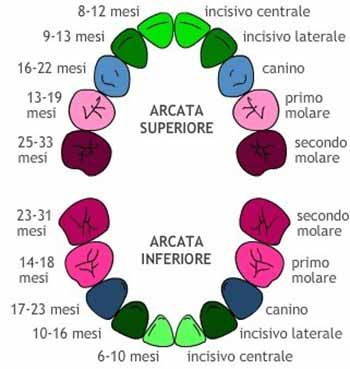
SYMPTOMS OF A TOOTH THAT IS POINTING
Infants or very young children do not understand well the discomfort they feel in the mouth and at least up to a certain age they are unable to signal the problem to their parents. The "grown-ups", however, easily notice the sprouting of a new tooth as red and inflamed gums are noted and after a few days to the touch it is possible to feel the roughness of the tooth that is cutting the gum. This is usually the time when the baby feels the most pain.
Other symptoms of ongoing teething can be: irritability and crying especially at night, sour poop or diarrhea, difficulty sleeping o fever. The latter is not so much due to the fact that a tooth is emerging but rather to a greater weakness of the immune system at such a delicate moment in the life of the newborn.
Another unmistakable symptom of a sticking out tooth is theincreased salivation and copious appearance of drool, this can also happen many weeks before the real tooth comes out. Often children, at least on the most critical days when the tooth is cutting the gum, eat less.
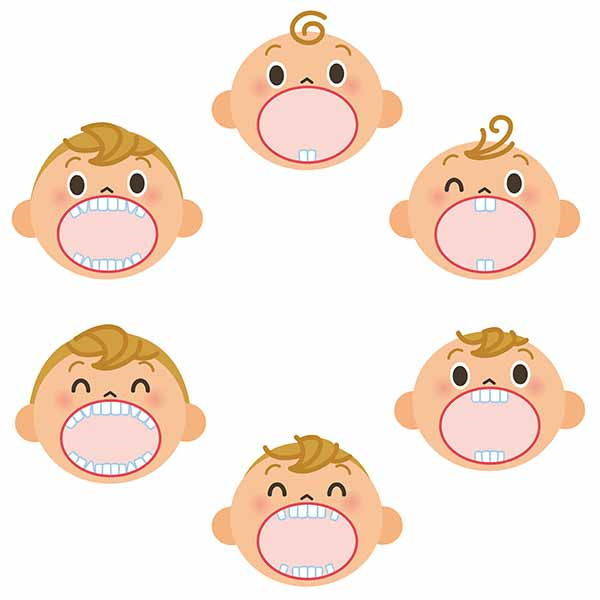
I symptoms of teething that can be seen are therefore:
• Swollen gums
• Red or bleeding gums
• Feeling rough or pointed to the touch when touching a gum
• Irritability
• Major crying
• Sour poop or diarrhea
• Temperature
• Difficulty sleeping
• Increased salivation and copious drool
• lack of appetite
NATURAL REMEDIES AGAINST THE PAIN OF THE POINTING TEETH
The appearance of teeth can be a very painful time in the life of babies and children. There are systems and natural remedies to try for try to alleviate the symptoms of teething a little. These are in particular games to bite or gel to apply on inflamed gums but also compresses, massages on the gums or the use of some stones such as amber or roots to suck and nibble like that of iris.
GAMES TO BITE
On the market there are games to bite of different materials and formats that go previously messi in freezer and then proposed to the baby in the teething phase who will put them in his mouth with pleasure feeling the fresh and hard material. The cold in fact relieves pain and acts as a bit of an anesthetizer.
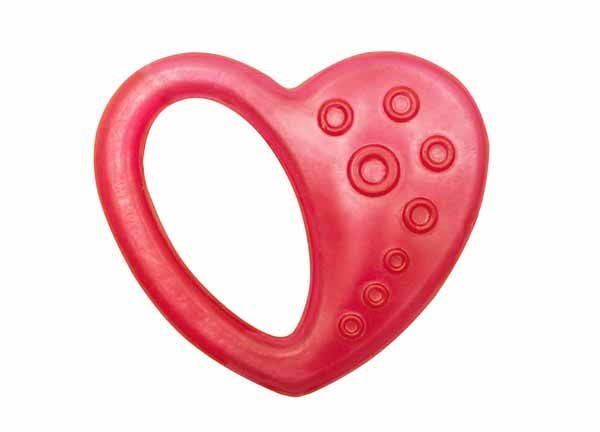
ALOE VERA GEL
There are specific gels based on natural substances such as aloe vera that you can smear on sore gums of newborns several times a day to decrease pain, burning and discomfort.
AMBER NECKLACE
Many mothers have managed to relieve their children's painful teething problem with an amber necklace or an amber bracelet that the baby must always keep on his back. According to natural medicine, this stone would be able to promote teething by decreasing the pain associated with it. However, there are no studies on this to confirm its effectiveness.
HOME MADE ICE LOLLIES
Since the cold plays in favor of pain reduction, it might be useful to make some homemade popsicles, perhaps based solely on fruit, to be offered to children in the moment of acute pain. Here you will find some useful recipes.
Read also: 5 NATURAL HOMEMADE ICE LOLLIES
COLD WATER PACKS
Even simple cold water compresses to which a pinch of baking soda can be added can relieve the pain of little ones. They can be done using a soaked gauze and repeating the operation several times throughout the day or whenever the boy or girl is in pain.
IRIS OR PURPLE ROOT
Iris or violet root is an ancient folk remedy for teething. It is about a hard root which, however, when chewed by the young, softens and becomes elastic. It appears to have a calming and pain relieving effect. It hangs around the child's neck so that he can use it whenever he wants.
BREAST FEEDING
If the baby is breastfed, in the acute pain phase, he will likely find relief when latching on to his mother. Breast milk in fact it is not only nourishment but also cuddles and one of the best cures against the suffering of children.
CHAMOMILE
Even a little warm chamomile tea can help calm the baby down especially if you have difficulty sleeping or he cries inconsolably.
HOMEOPATHIC REMEDIES
There are also homeopathic remedies specifically designed for teething. They go though always recommended by your pediatrician of trust.
WHEN MILK TEETH FALL
Milk teeth generally fall out over the next period of time from 6 to 14 years of age, it is at this point that the deciduous ones are replaced by the definitive or permanent teeth.
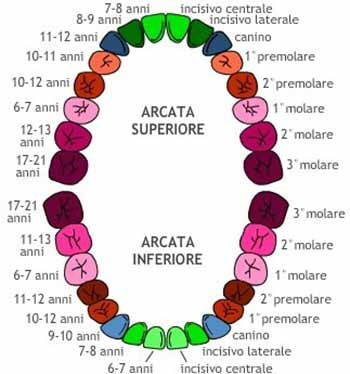
WHEN TO START CLEANING CHILDREN'S TEETH
As soon as the first teeth begin to appear, they should already be taken care of both to avoid the appearance of cavities (yes they can also appear in milk teeth) and to familiarize with this good habit so important from an early age. Generally, the earlier you start, the easier it will be to maintain the habit of brushing your teeth even in later years without too much resistance from children.
Among other things, the idea that since they are milk teeth then it is superfluous to brush them is completely wrong. Although it is true that any caries that may have appeared on these teeth are destined to disappear with their fall, it is also true that decayed deciduous teeth often prelude to the appearance of caries even in the definitive teeth.
So it is important to teach your children to brush their teeth as soon as possible. You might find some useful advice about it:
FIRST MONTHS
The first teeth that appear are possible clean with a piece of damp gauze that it is also good to pass on the gums of teeth that have not yet grown, a gesture that not only helps maintain oral hygiene but can also help teething while also giving some relief in case of discomfort.
AFTER THE YEAR
Around the year of age, the baby should already familiarize yourself with the toothbrush. Of course, you have to choose a specific tool designed for the little ones, small in size, with the soft and nice colored bristles to attract his attention like a toy. You start by brushing with water only in the evening or better still morning and evening then you can buy a toothpaste for children (there are 100% organic made with food grade ingredients) which will be used very sparingly (the quantity corresponds to that of a lentil ). Only then will other types of toothpaste be chosen (when the child is used to it and has learned to spit after brushing his teeth).
This phase is crucial because if the child around one year of age gets used to brushing his teeth by taking it as a game, it will be easier after making it continue independently. It should also be emphasized that children tend to imitate what their parents do, therefore make the time for washing the little ones coincide with yours in order to entice them to imitate your gestures and your good habits in terms of dental hygiene.
HOW TO CLEAN THE TEETH OF BABIES AND CHILDREN
As already mentioned in the case of newborns, a simple gauze with water must be used to pass over the teeth and gums. On the other hand, when the children have grown older, they must be taught to brush their teeth slowly and patiently.
If the child has good dexterity let him do it alone for as long as he wants but always helping him towards the end with some brushing done well. Once he has become familiar with the fact that your surgery will eventually be required, increase the time of this second phase a little to ensure that the teeth are actually brushed correctly.
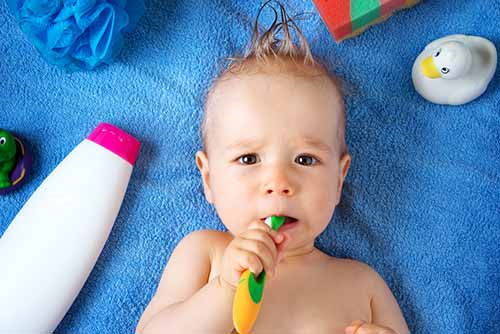
Let's now turn to the technique to use. Need imagine the mouth divided into six parts.
1. front above
2. front below
3. rear right above
4. rear left above
5. rear right below
6. rear left below
The first two groups have two "sides":
1. Interna
2. External
The other four groups have three "sides":
1. Interna
2. External
3. Above
All the facades have to be washed and there is no problem in using horizontal brushing for children (as is the case for adults). It is therefore necessary pass on each side 3 or 4 times, everything is done quickly (less than a minute), little by little obviously you can do a more precise job with the collaboration of the child who may have got used to it and has a little more patience.
Read also: HOW, WHEN AND WHY TO CLEAN CHILDREN'S TEETH
Rinsing, on the other hand, is something that is taught slowly and therefore, even if children initially ingest a small dose of toothpaste it is not a big problem (especially if you have chosen a natural one), in a short time they will learn to manage the water in the mouth and then to spit it out.




